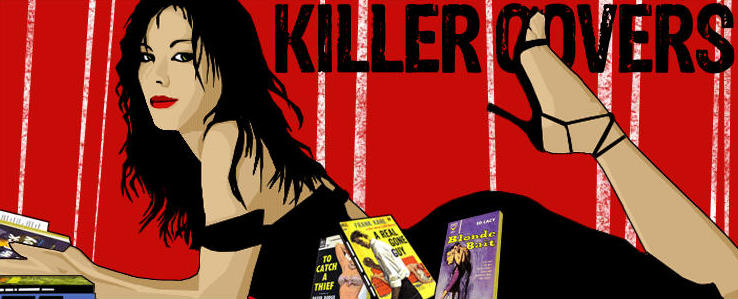Part of a series saluting artist-illustrator Mitchell Hooks.
 Angel’s Flight, by Lou Cameron (Gold Medal, 1960)
Angel’s Flight, by Lou Cameron (Gold Medal, 1960)
Today ends a full month of Killer Covers’ tribute to Detroit, Michigan-born artist
Mitchell Hooks (1923-2013)—twice as long as I had originally intended to let it run.
The series began on Wednesday, March 18, which—in addition to being the seventh anniversary of
Hooks’ demise, at age 89—also happened to be the day that Washington Governor Jay Inslee required all “non-essential businesses” in my hometown of Seattle to be
shuttered because of the COVID-19 crisis. I extended this series because there were just so many excellent examples of Hooks’ work to consider. Through yesterday, 57 paperback fronts painted by Hooks had been displayed as part of this venture, plus
a couple of movie posters. That’s in addition to dozens of Hooks creations Killer Covers

has showcased before, including his 1970s line of covers for
Ross Macdonald’s Lew Archer novels and the façades he crafted during that same decade for Paperback Library’s
Superspade novels by “B.B. Johnson,” aka songwriter-composer
Joseph Perkins Greene.
(Right) Artist Mitchell Hooks, photo by Tom Halloway
Although the novel coronavirus is still with us (and will likely
remain a long-term cause for social isolation, despite Donald Trump’s pixie-dust wishes to the contrary), it’s finally time to call this project done. But not before I share another 40 of my favorite Hooks works. Below you will find covers from mainstream novels as well as entries in a wide variety of genres, from crime fiction and science fiction to westerns and tales of espionage. Especially notable among this bunch: Ugo Pirro’s
The Camp Followers (Dell, 1959), which was made into a
1965 film of that same name; two thrillers by
Georgette Heyer,
Death in the Stocks (Bantam, 1971) and
Duplicate Death (Bantam, 1970); the haunting 1956 Gold Medal cover from Geoffrey Homes’
Build My Gallows High;
That Darn Cat (Bantam, 1965) and its sequel,
Undercover Cat Prowls Again (Bantam, 1967), by Gordon and Mildred Gordon, which enjoyed popularity because of a
Disney adaptation of the former comedy-thriller; the 1961 Gold Medal edition of Fredric Brown’s carnival-themed mystery,
Madball; the hilariously named Lionel White novel,
Death Takes the Bus (Gold Medal, 1957); and
The Dark Arena, the 1956 Dell release of
Mario Puzo’s debut novel, originally published in 1955.
Click on any paperback cover here for an enlargement.
































Although Hooks’ art is occasionally confused with that of
Ernest Chiriacka or
Robert McGinnis, there are signature elements to it that make clear who was holding the paintbrush.
Throughout much of the late 20th century, Hooks perfected a sketch-like linear style. “It was looser, more spontaneous, more designy, a slightly impressionistic way of working,” as the artist told Gary Lovisi of Gryphon Books during an
interview in 1988. “It was what I felt good doing then.” Hooks’ women—and there were lots of them in his images; paperback publishers wanted them emphasized on covers—tended to be sensuous, but “not cheap or sleazy at all, they have class and elegance,” as Lovisi put it.
Some early illustrations show how much Hooks’ style evolved. Glancing over the half-dozen books below, all released between 1950 and 1953, you can see he was using a more realistic, painterly approach, similar to what many others offered at the time.
He would eventually return to a more realistic style of painting, as he worked increasingly with oils and as the market changed.






Finally, let’s gaze fondly at one of Hooks’ few wraparound covers, for the 1951 Lion Books release
The Ranch Cat, by William Hopson.
As the Vintage Paperback & Book Covers Facebook page
explains, Hopson “wrote westerns for the pulps, contributing to
West,
Exciting [
Western],
Popular [
Western], and
Mammoth Western, but he did do some work for
Thrilling [
Detective],
Popular [
Detective], and
Mammoth Detective as well. He managed to leverage his pulp career into paperback success postwar.” Most of Hopson’s books (
Trouble Rides Tall, Yucca City Outlaw, etc.) were issued in the ’50s.
Needless to say, there are dozens more Mitchell Hooks covers in my computer files. I’ll try to find uses for others in the future. Meanwhile, check out the collections in
The Rap Sheet and
Flickr.

































































